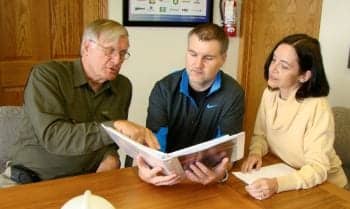
Dennis Isernhagen, Curt DeWeese, and Ginnie Halling evaluate improved outcomes in industrial work.
Today, rehabilitation professionals recognize the importance of outcomes as a means to obtain better reimbursement in the usual therapy billing system. However, the complex system that now governs reimbursement can create confusion in determining what therapists are truly trying to accomplish. Counting units of time or deciphering billing codes comes from an environment where cost-containment is active and the focus is on paperwork. This narrowness may keep therapists from viewing patients as functional whole people. We need to know who benefits from our services. The right outcome measures can focus us on outcomes that patients, referrers, and payors want (see Figure 1).
Therapists can measure increased range of motion, increased strength, and reports of decreased pain. But if the “whole person’s functionality” is not evaluated, treated, and measured, a larger and very critical goal is missed. In sports, therapists find out if players successfully returned to the sport. In rehab, therapists find out if the patient went home independently. But with musculoskeletal patients who work (workers’ compensation or not), many therapists don’t know whether there was a safe return to work and if the worker could continue production without a reinjury.
There are two reasons why rehabilitation personnel have been inhibited from aiming at good outcomes for return to work (RTW):
- Therapists are not typically the decision makers in return to work. Physicians make the final decision; they often “estimate” restrictions without objective work ability information from therapists who could measure it. Therefore, the ultimate decision makers, including the employer, do not view therapists as pivotal in return to work. The same disconnect happens with the worker. If the therapist has not gone through specific functional evaluation of a worker’s ability to do a job, the worker perceives the therapist as a “treatment” provider and not involved in the outcome of safe return to work.
- While therapists work toward “clinic” goals, they often do not find out what happened to their worker/patient after discharge in a “real world” setting. Return to work, particularly to the original job, is a strong outcome measure. And the process of obtaining it creates a bond with the employer and the worker that is more powerful than any marketing material.
FIGURE 1.
Outcome goal or action for your patients
Score 1: I rarely use this as a goal
Score 2: I include this goal some of the time
Score 3: One of my top goals
- Decrease pain
- Increase motion
- Improve muscle strength
- Increase or restore capability for a whole body function such as climbing or lifting
- Measure function against specific work demands to quantify and report to work ability
- Do follow-up after discharge to identify if return to work was successful
Satisfaction is also a recently measured outcome. With “patients,” it can be a factor of recovery or good therapist-patient relationships. Workers, when work ability is restored, feel they have received the best care. Interestingly, when the patient returns to work activity, therapist satisfaction rises as well.
Below is a checklist to determine where clinicians’ priorities lie and can be expanded.
Scoring: Add scores 1-3 for a total number of points. Add scored 4-6 for a total number of points. To be producing outcomes important to your patients and their referrers, the scores for 4-6 should equal or be higher than scores 1-3. If the work oriented scores are low, the following are common negative consequences
- The worker/patient is discharged, feeling well, and goes back to work. Prevention of reinjury has not been taught. The worker becomes reinjured.
- The worker/patient is discharged, feeling well, and goes back to work. The same forces that created the initial injury are still present and create another injury.
- The worker/patient is discharged meeting most of treatment goals. He or she goes to a physician who writes restrictions below what the therapist would have estimated. As a result, the worker/patient stays off work. Or the worker/patient returns to rehab and the cycle continues.
SECURING GOOD OUTCOMES FOR RETURN TO WORK
- Know the specifics of the job the worker/patient performs. Subjective or generic job descriptions are inadequate for specific treatment goals. Going on-site to view the job and the work environment, and measure specific functions provides an accurate job description. Initiating this work at the employer site allows the rehab professional to meet the on-site “return to work team” with whom the patient will need to work.
- Use this job description as the base for setting treatment goals of function.
- Measure against the job goals sequentially during treatment until they are met.
- Provide ongoing job matching information to the physician and the employer.
- Satisfy the worker/patient needs by having them participate in work-oriented treatment and job function testing. This builds the worker’s confidence. Our outcome studies show that they are pleased that their job is understood and valued.
- At discharge, do the final report of the worker’s ability against the job description. Provide the information to the physician as part of the release to work. Physicians appreciate objective information that links the patient and the job. In workers’ compensation cases, provide the employer with the job matching information.
- If necessary, recommend job modifications specific to a job task so that the worker and employer both understand that the task can be performed with the modification.
- Do a follow-up visit at the worksite, answering any questions about work functions while viewing the job. Positive reinforcement of the worker’s ability, the employer’s productivity need, and pertinent ergonomic ideas are discussed. Minor adjustments may be made.
- Set up a formal outcome system; call 6 months after discharge. Make the calls to all the worker/patients or employers in cases where the worker/patient was discharged having met the goals successfully. Pertinent questions are:
- Is the worker still working: yes or no?
- If working, are they at the workplace to which they were discharged or another workplace?
- Are they at their regular job or a different job?
- Have they worked without a reinjury of the same type?
- Have symptoms reoccurred? Do they need assistance?
- Are there more services you can provide to the employer and its workers?
These questions can be broader and more detailed depending on outcome needs. But the most important parts are to determine whether the rehab services have resulted in a return to work. That will give a percent success rate. Overall, if the rehab facility can identify a percent return to work of all patients discharged, it gives a goal to improve upon, informs the staff of effort outcomes, and almost always gives numbers that will impress referrers. The other benefit is that, by the process of making worker and/or employer calls, the therapist reinforces a strong role in the RTW system.
Outcome calling can be assigned to an office person or appropriate party within the clinic who represents the program well. Because the caller is not the therapist who did the treatment, the results will not have that bias. Begin to look for patterns in the return to work. To what are the successes due? Who were the pivotal professionals involved? Create a matrix of RTW outcomes, and you will begin to build your marketing strategy, your ideas for further improvements in your work, and knowledge of potential barriers in return to work that you can begin to address. In our clinic, we learned of barriers to RTW despite our good rehab work. That encouraged us to communicate our objective RTW information to additional parties to reduce barriers caused by inadequate information.
Of importance is the feedback to the therapists and treatment team who recognize that their work in the clinic has impact beyond clinic walls. This can bring pride and recognition both within and outside the clinic.
OUTCOME MEASUREMENT HAS ITS OWN OUTCOMES
By doing outcome measurement, both the clinic and the therapists rise to a higher level of recognition. The perception is that those who care about the important return to work outcomes are professionals to trust. Employers, case managers, and some insurers are impressed that you believe in your services and do return to work outcome studies.
If you have competitors, ask your employer and case manager referrers to compare your good outcomes with other clinics. Few or none will have outcomes at all. The point will be made.
In addition, this begins to build your network of interactive stakeholders. You become part of a team all interested in safe, efficient, productive return to work. Positive outcome measurement in return to work is a strong step to make the rehabilitation team and therapist a pivotal part of the health care/workers’ compensation system.
Susan J. Isernhagen, PT, is a developer and practitioner in work injury management and prevention. Her published peer-reviewed research includes reliability of assessing functional capacity performance and identifying predictors for return to work. She has presented education and training internationally to occupational medicine physicians and rehabilitation personnel, the US military, and employers. She is editor/author of texts and journals: The first three chapters in the comprehensive Guide to Functional Evaluation published by AMA Press, 2009; The Comprehensive Guide to Work Injury Management (1995); Work Injury Management and Prevention (1988); three volumes of the journal WORK (2006, 2001, and 2000); and 30 articles on occupational health in professional journals and publications. She is the recipient of the APTA Kendall Award for practice. Isernhagen can be contacted at .




